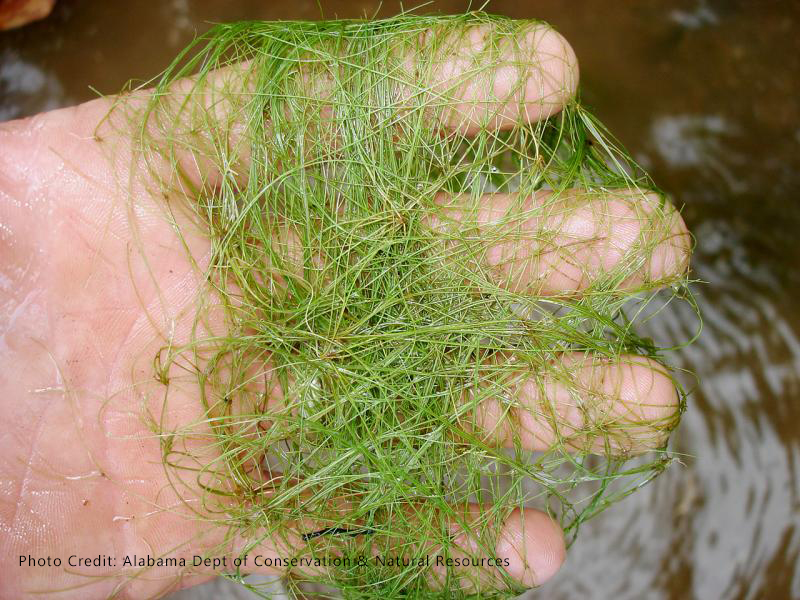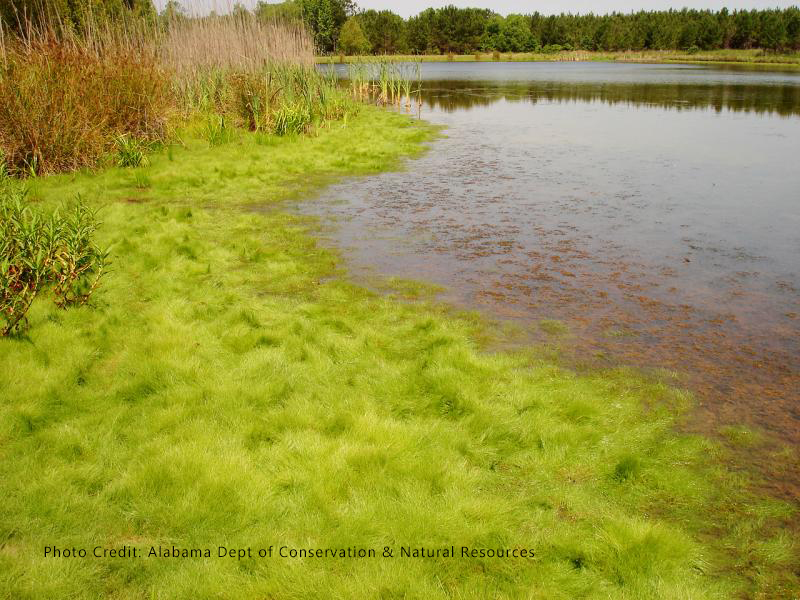
Slender Spike Rush: Is it Invasive?
Note: All photos are credited to the Alabama Department of Conservation and Natural Resources
Our lakes and ponds are home to a vast amount of aquatic life and vegetation. Eleocharis baldwinii, commonly known as slender spike rush or needle spike rush, is one of the many aquatic plants you may find in your lake or pond. Known for its thin, needle-like stems and modest height, this aquatic plant thrives primarily in shallow, nutrient-rich environments and paints strokes of green across waterbodies. However, beneath its unassuming appearance lies the potential for significant ecological impact.
Originally hailing from various parts of the globe, including North America, Europe, and Asia, the spike rush coexists harmoniously within the ecosystem, contributing to the biodiversity and health of wetlands. Yet, when a slender spike rush finds its way into territories beyond its natural borders, it can become an invasive concern, altering the ecological balance of ponds and lakes.

How To Identify Slender Spike Rush
Identifying invasive aquatic plant species can be difficult for the untrained eye, given their various growth phases and specific habitats. The slender spike rush is known for its slender, grass-like appearance and exhibits key characteristics throughout its different growth stages that can aid in its identification. In its early stages, it often presents with bright green, cylindrical stems that are smooth and bear tiny, inconspicuous flowers at the top. As the spike rush plant matures, these stems can grow up to almost 16” tall, maintaining their slender profile. This species thrives in wet environments, typically found at the edges of ponds, in shallow water, or in saturated, muddy areas. It prefers full to partial sunlight, making the edges of water bodies an ideal habitat.
Distinguishing slender spike rush from other spike rush plants can be challenging due to the subtle differences among species. However, its notably thin stems, which are less than two millimeters thick, and the absence of leaf blades are distinctive features. In addition, its seeds are smooth and lack the tubercle (a small, rounded projection common in other species), which is another identifying characteristic.

Is Slender Spike Rush Good For Your Pond?
Depending on where your waterbody is located, slender spike rush can be beneficial or harmful to your pond’s ecosystem. Native to the southeast and southwest of the United States, slender spike rush can serve as a food source for various animals, including insects and some waterfowl, which rely on it as part of their diet. Ecologically, slender spike rush plays a significant role in water filtration and habitat creation, contributing to the overall health and balance of the pond environment. It can help stabilize the pond’s edges, reduce erosion, and provide breeding grounds for amphibians and nesting sites for birds.
However, it’s important to consider the potential downsides. Though slender spike rush is native in the southeast and southwest, it can become invasive in other regions, spreading quickly and potentially outcompeting native vegetation. This rapid growth can lead to difficulties in managing the pond’s ecosystem and may require active measures to control its spread and maintain ecological balance.
Another downside to slender spike rush is that it can detach from the bottom of the pond and float to the surface where it forms a large floating mat. This promotes surface algae growth while also limiting sunlight penetration for submersed plants. Therefore, it is important to monitor aquatic vegetation and remove excess growth regularly.

How To Manage Slender Spike Rush
Managing invasive slender spike rush requires a strategic approach – and aquatic experts at SOLitude can help. Our annual lake management plans can be tailored to meet the unique needs of your waterbody and ensure the removal of invasive aquatic plants. We have a variety of solutions to choose from, such as mechanical removal via hydro-rake, aquatic herbicides, and triploid grass carp.
Aquatic herbicides can target invasive vegetation while minimizing the impact on beneficial plants and aquatic life. To ensure safe applications, SOLitude only utilizes EPA-registered herbicides and our Aquatic Specialists regularly undergo training and recertification. When controlling slender spike rush specifically, a specialized herbicide is often required to achieve control.
For those looking for non-chemical solutions, mechanical removal or triploid grass carp may be an effective solution. Mechanical removal via a hydro-rake is an effective method for physically extracting the slender spike rush and other invasive species from the waterbody. Tripold grass carp are sterile fish known for their appetite for certain types of aquatic vegetation, including slender spike rush. They can serve as a natural, ongoing control measure, helping to reduce the reliance on chemical treatments. Before stocking your lake or pond with grass carp, it is crucial to check your state’s local regulations to ensure it’s legal.
By partnering with SOLitude Lake Management, property owners can achieve sustainable control over invasive species like slender spike rush and safeguard the ecological balance of their aquatic environments. Contact the experts at SOLitude today to learn how we can keep your water body free of invasive aquatic plant species.
How Pond Weeds Develop & Control Strategies
Contact Us for Slender Spike Rush Control
Call us at 888-480-5253 or complete the form below to connect with an aquatic management expert.
SOLitude Lake Management is a nationwide environmental firm committed to providing sustainable solutions that improve water quality, enhance beauty and preserve natural resources.
SOLitude’s team of aquatic scientists specializes in the development and execution of customized lake, stormwater pond, wetland and fisheries management programs. Services include water quality testing and restoration, algae and aquatic weed control, installation and maintenance of fountains and aeration systems, shoreline erosion control, muck and sediment removal and invasive species management. SOLitude partners with homeowners associations, golf courses, private landowners, businesses and municipalities. SOLitude Lake Management is part of Rentokil, a leading business services company, operating across the United States, Canada and Puerto Rico.
For more information, visit SOLitude Lake Management at solitudelakemanagement.com, and connect on Facebook, LinkedIn and Twitter.









